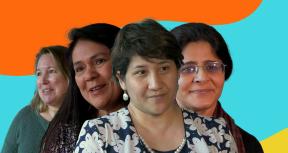Elena Bardasi presented these findings at the 2024 Fragility Forum session “Gender Equality in FCV Settings: Moving from Humanitarian Responses to Creating Resilience.” Check also the podcast: 🎧 Reaching women and girls trapped in violence and conflict.
Land ownership among women in conflict-torn regions is far from the norm. When, as part of a World Bank project sensitization campaign, a group of women in Burkina Faso approached traditional leaders to request and acquire their own land parcels, they broke through deep-seated cultural barriers that have persisted for generations. “With all this information and the chief here in person, I had the courage to go and ask him for the plot. Thus, I acquired it. I did not know I could do this,” reported one of the young women.
Achieving this level of change is no easy task. It requires activities that are tailored to the context and the needs and expectations of targeted groups (they need to be relevant); that involve local actors in planning (to build inclusive ownership); and that tackle the root causes of gender inequalities (they need to be “deep”). Making change sustainable and scalable is even more difficult. The World Bank Group recognizes that when its support to countries achieves relevance, inclusive ownership, depth, sustainability, and scale, it can achieve meaningful and lasting results.
A recent Independent Evaluation Group (IEG) evaluation considered these elements to assess the quality of the World Bank’s support to promoting women’s and girls’ economic empowerment and to addressing gender-based violence in fragile, conflict, and violence-affected countries.
IEG found that most projects have achieved some of these elements—more intensely in new project designs. However, not a single project achieved all five elements. This prompts a bigger question: can individual projects realize meaningful and sustainable change? Or would a strategic country engagement approach—which relies on multiple activities operating in sync—be more effective to address gender inequalities?
IEG’s evaluation offers insights that point to potential answers.
Reaching all marginalized and vulnerable women and girls
Among women, there are social differences and power relations that need to be considered. Projects are more inclusive when they identify the needs of, and constraints faced by, different groups of women and girls and tailor interventions to each of them. These include specific activities for women who are marginalized because they are young or because they belong to an ethnic minority, are illiterate, are the head of a household, or live in remote areas.
Actively involving local stakeholders at the very early stage of a project and building inclusive ownership is also key. Local governments, grassroots and community-based organizations, women’s organizations, and other local stakeholders can enrich project designs with their unique local perspective. Listening to local actors makes initiatives more relevant, effective, and sustainable.
Addressing the root causes of gender inequalities
The root causes of gender inequalities are complex and require “deep” approaches that are integrated and comprehensive. Only a few of the projects analyzed by IEG met these qualities. One such project is the Sahel Women’s Empowerment and Demographic Dividend project, or SWEDD.
What makes SWEDD a “deep” project?
SWEDD uses a multisector strategy and multiple entry points to increase women’s and girls’ empowerment and their access to reproductive health. On the supply side, the project improves the quality of reproductive health services, while on the demand side, it builds girls’ and women’s capacity to make decisions, including about their fertility, and use of reproductive health services.
SWEDD also aims to change gender norms through media and community-based communication activities and by actively engaging men, boys, and political, religious, and traditional leaders to work toward eliminating gender-based violence. Furthermore, SWEDD engages with governments and other key national stakeholders to support policy reforms to advance gender equality.
These multisectoral, integrated approaches add depth to the project and also contribute to its sustainability.
Achieving sustainable results at a large scale
IEG found sustainability and scale to be the most difficult elements for projects to pursue. Achieving sustainability and scale requires stability, strong institutions, and strong financial capacity of national and subnational governments, which are rare in countries affected by fragility, conflict, and violence.
SWEDD, for example, has struggled to bring its achievements to scale. Scaling up a bundle of multisectoral, interconnected interventions to achieve deep change requires large financial resources that are difficult to mobilize in fragile environments. As an informant interviewed for IEG’s evaluation reported, “there are plenty of girls on the waiting list. Resources are the challenge for scaling up. It is an exorbitant cost. In the country, there are one million girls at risk of child marriage, but we cannot support more than 600 girls. The expertise is there, the political will is there, the communities are welcoming. Now it is a matter of resource mobilization. The World Bank alone cannot meet these needs.”
Shifting from a project to a country focus
IEG’s findings indicate that individual projects cannot achieve transformational change. Regardless of how much improvement projects make on different elements of change, they face trade-offs, especially when it comes to depth, sustainability, and scalability.
Escaping these trade-offs requires the Bank Group to fundamentally shift from its current project-by-project approach to a more comprehensive country engagement approach that guides its overall support. A country engagement approach to gender equality is one where the World Bank uses an integrated portfolio of activities, regular policy dialogue on gender issues, and coordination and collaboration with other development partners (including civil society, women’s organizations, and gender networks) on the country gender agenda. Only a country engagement approach can enable the systemic changes that are needed to address gender inequalities and support long-term, integrated, and multisectoral interventions, simultaneously meeting immediate humanitarian and longer-term development needs.









Comments
Thank you Serena! Let’s…
Thank you Serena! Let’s catch up!!
Add new comment